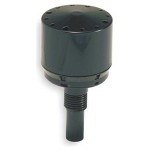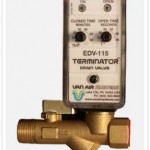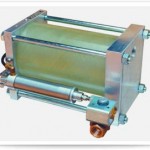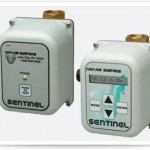Automatic Drain Valves in Compressed Air Systems
Picking the right type of automatic drain valve can be tricky. You need to consider initial cost, product reliability, operating cost, and any constraints that are unique to the application.
Auto drains remove condensed liquid – usually a mixture of water and compressor lubricant -- from compressed air systems. Automatic drains are commonly installed on air receiver tanks, drip legs, bulk moisture separators, coalescing filters, refrigerated air dryers, and deliquescent air dryers.
As the name implies, auto drains remove human labor from the mix. Buy an automatic drain valve and a maintenance worker no longer needs to patrol the plant, manually dumping liquid from the air system. At least that’s the theory.
Let’s look at a few different type of auto drains and talk about their strengths and weaknesses.
Internal Float Drains
We’ll start with the least expensive variety of auto drain, the internal float drain. Wilkerson, among others, makes these drains, as shown in the image below.

Internal Float Drain
Internal float drains insert into the bowl of a coalescing filter or moisture separator. Within the device is a float that normally seats on a small orifice. When liquid enters the drain the float rises off its seat, exposing the orifice and allowing liquid to discharge through the stem. As the liquid level drops, the float re-seats and seals the orifice. No compressed air vents in the process.
These types of drains are inexpensive, normally less than $50, but they’re also notoriously subject to clogging or sticking open. Compressed air systems, especially older ones, contain lots of dirt, dust, pipe scale, and oily water. These contaminants tend to plug the orifice within a float drain. The orifice can also become partially obstructed, preventing the float from seating and allowing compressed air to continuously leak. As you should know, leaking compressed air places an artificial load on your compressor and needlessly runs up your electric power bill.
Bottom line: The price is right. But you get what you pay for.
Timed Solenoid Drains
Timer drains are pervasive in compressed air systems with 25 horse power of compression and smaller. These devices consist of two main parts: a timer and a solenoid valve. The timer controls the interval and duration of the solenoid valve’s actuation. Usually the open time can be adjusted from one to sixty seconds, and the closed time can be adjusted from one minute to sixty minutes.
Many companies make such drains, including Van Air Systems. Our model EDV-115 is shown below.

Timer Solenoid Drain Valve
Timer solenoid drains are relatively inexpensive, usually costing from a bit over $100 to $250 depending on the style and options. These drains are more resistant to clogging than internal float drains, although the orifice within the valve through which fluids flow is small, usually 3-5 millimeters. This orifice can plug up and should be protected with a y-strainer, which itself needs period cleaning. Also timer solenoid drains inevitably purge compressed air along with liquids.
Bottom line: Inexpensive and mostly reliable. Service often and adjust the controls or you’ll waste a ton of air.
Electronic Level Sensing Drains
A level sensing drain uses a water capacitance sensor to signal a valve when to open and shut. This approach eliminates the biggest drawback to solenoid timers drains, the loss of compressed air. Level sensing drains are called “demand drains” because they only activate when liquid is present. Their cost is higher than the other types of drains we’ve discussed so far, usually several hundred dollars or more.
The Achilles heel of level sensing drains is contamination of the sensor, which is more likely in air systems with high levels of oily water. Also these drains typically do not use a valve with a straight through liquid flow pattern – the liquid takes a contorted path through the reservoir and diaphragm valve before being discharged. In air systems with high solids content, this contorted flow pattern can spell trouble. Cleaning the drain regularly is a god idea.
Bottom line: Reasonable price and doesn’t waste air. Sensor can foul. Most reliable in clean systems.
Pneumatic Zero Loss Drains
These drains are simple, robust, and pricey. The concept is straight forward. An external condensate reservoir collects liquid. When the liquid rises to a set point a mechanical switch sends pilot air to an air cylinder that opens a ball valve, draining the reservoir. As the level of liquid in the reservoir drops, the mechanical switch closes, shutting off the pilot signal and closing the ball valve. No compressed air is wasted in the process, except for the tiny amount of pilot air. The ball valve has a straight through flow pattern so these drains are resistant to clogging and blockage.
Van Air Systems offers this style of condensate drain in its PDV-500 Series, pictured below.

Model PDV-500T Zero Loss Pneumatic Condensate Drain
The draw backs to these drains are twofold. One, they’re expensive. Two, they take brains to install. If the control air and balance lines are installed incorrectly, the drain won’t work.
Bottom line: Costs a lot. Works great. No wasted compressed air. Makes most sense in big air systems. Highly reliable in contaminated conditions.
Motorized Timer Ball Valve
These drains are a specialty of Van Air Systems and are dear to me. I built them over summer breaks in high school and college. There are a few different manufacturers of these. Bias aside, ours are the best. The latest generation is our MDV-400 Series.

MDV-400 Series Drain Valves
The idea is very simple. The MDV consists of a motorized actuator with an integrated and adjustable timer sitting directly atop a ball valve. These drains are synonymous with torque. We have models that deliver up to 900 foot-lbs. of torque. One of my former colleagues used to call the MDV-400 a pencil eater. He’d demonstrate the torque of the actuator by inserting a pencil into the valve while it was turning. Of course the valve cuts through the pencil like soft butter.
The idea is to use these drains on wet receiver tanks, compressor inter-coolers, separators, and filters with very high contaminant levels. The high torque valve easily slices through particulates and oily sludge. These valves can also be used outdoors, and are less subject to freezing that other drain valves.
Obviously, these are not zero air loss drain valves. (I prefer to call them zero clog drains.) MDV-400 drains blow out air, water, and particulates. In many applications that’s exactly the point. Get that junk out of the air system! Still, purging of compressed air is an operating cost that needs to be understand when selecting your drain.
Bottom line: High end, purges air, exceptionally reliable, great for systems with solids in the condensate.
